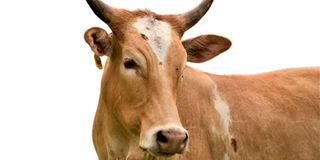Prime
Saving the Zebu by breeding the climate-smart Tyrol

A 2018 research by scientific research hub, ScienceDirect concluded that great changes have occurred in livestock management due to increased specialisation and mechanisation.
In particular, a strong focus on high-yielding exotic breeds has led to a considerable decline in the diversity of indigenous livestock breeds neglecting their cultural benefits and genetic diversity.
The Ankole long-horned cattle (also known as inyambo or Sanga) and East Africans shorthorn Zebu constitute the main traditional cattle breeds in Uganda. Other breeds are variants and intermediates of the two including Nganda, Nkedi, Kyoga, Nyoro and Kigezi, which constitute an estimated 93.3 per cent of the Ugandan herd.
In 2010, the Ministry of Agriculture, Animal Industry and Fisheries (Maaif) estimated that indigenous cattle supported about 26.1 per cent of Ugandan families through provision of food and income in addition to the supply of socio-cultural wealth and security.
In the shadow of hybrids
The Ankole Longhorns were on the brink of extinction because of cross-breeding with heifers until government deliberately started conservation in the early 2000s. A 2015 report by Dr Bright Rwamirama, then state minister for agriculture explained that after the war, there was a policy of importing high performing cows to encourage farmers gain from declining farming spaces.
“However, along the line we realised that perceived high performing animals sometimes were not necessarily efficient,” Rwamirama told the BBC in a documentary about saving Uganda’s Ankole longhorns.
The argument in defence of indigenous cattle was that they are drought and disease resistant able to survive on low quality forage and limited quantities of water.
Therefore, climate change is putting new pressures on livestock production making local breeds indispensable. Enock Rutsigazi, the co-founder of Cow Protection Conservancy Uganda explains that indigenous cattle, especially the Ankole longhorns were held for good reasons.
He explains that having cattle was not only a sign of prestige but had significant cultural attachment in marriage for paying bride price. Local cows also hold a strong link to the cultural heritage as a source of food in yoghurt, butter and ghee making as well as medicine among the cattle keeping communities. But their low meat and milk yields posed an economic dilemma in the quest to escape the poverty trap.
Saving the Zebu
The National Animal Genetic Resources Centre and Databank (NAGRC&DB), the government agency which manages the 11 livestock farms across the country, is now focused on conserving the biological diversity of its indigenous breeds.
They have done this by establishing a semen and ovary bank at the national conservatory as well as empowering breeding centres at Nshara and Ruhengere for the longhorns.
According to a research published in 1999, 22 per cent of African breeds had become extinct with Zebu listed among the critically endangered breeds. The zebu is adapted to dry environmental conditions and high temperatures and are known to be more resistant to tick infestation.
The traditional ecological niche of the short-horned Zebu, which is indigenous to eastern Uganda, is the key objective of Lusenke Stock Farm in Kayunga District and Kasolwe Stock Farm in Kamuli District.
The plan to revitalise Lusenke Stock Farm was announced in 2017 under the Lusenke Livestock Transformation Project (LULITRA) to conserve the Zebu and avail farmers with quality stock at affordable price. Lusenke, like the other stock farms across the country established in 1969, suffered neglect for years following the Bush War.
In 2017, Lusenke’s stock was barely 300 heads of cattle while by last year 461 cattle were in stock. Today, the herd has considerably increased to 739 cattle. Daniel Epinyu, a livestock husbandry expert and farm manager of Lusenke, says that the Zebu is among the endangered species and their unique genetics need to be preserved.
“Once a gene is destroyed, it is very difficult to recreate it. Conserving any species starts with ensuring the integrity and stability of its habitat,” he said. Zebus’ problem, like its relative the Ankole longhorns, is compounded in the lowly heritable traits.
Whereas the Zebu traits are carefully maintained, crossbreeding is the strategy taken to increase the productivity of the breed by introducing desirable qualities from Tyrol bulls.
The Tyrol Grey, a native of Australia is the preferred choice as it is considered to have excellent milk and beef performance. The females, for instance, grow up to their full size within three years and reach a weight of between 550 and 600 kilogrammes.
The Tyrol Greys too, have a good forage instinct and feed conversion, characteristics experts say are desirable. According to Epinyu, the first generation has a low accuracy estimated at 50 per cent traits of both Zebu and Tyrol. But he expects it to increase to about 75 per cent when the offspring are crossed. Subsequent breeding would raise to 100 per cent.
A large population size is perceived as the requirement to roll out community activities. “When the population is below the critical mass, it calls for continued breeding to generate a highly sustainable number that we can be able to give to communities as per our mandate,” says Epinyu.
Opportunities
According to Maaif’s website, the main objective of the breeding project is aimed at enhancing livestock production and productivity for improved livelihoods, food security, incomes and export. The target beneficiaries are farmers involved in livestock production in Kayunga, Buikwe, Buvuma, Mukono, Wakiso, Mpigi, Luweero, Nakaseke and Nakasongola. Farmers in these districts will be categorised into nucleus and smallholder farmers depending on the herd size, land acreage and willingness, among others.




